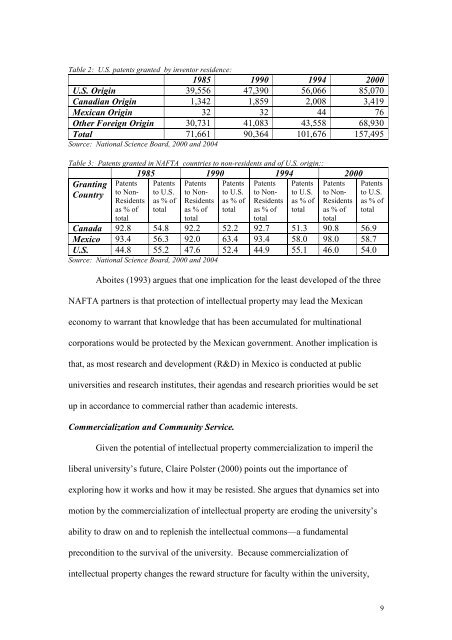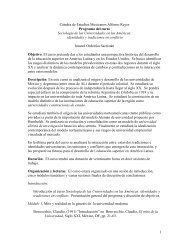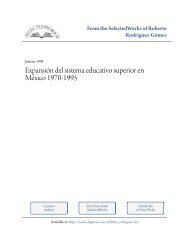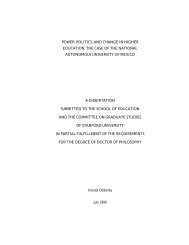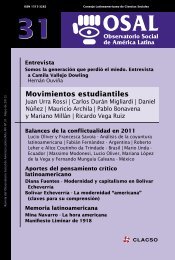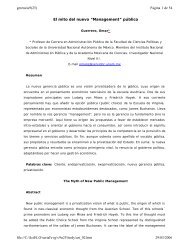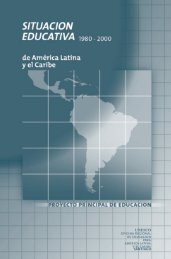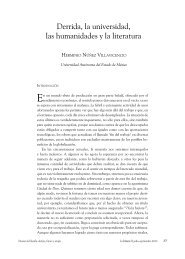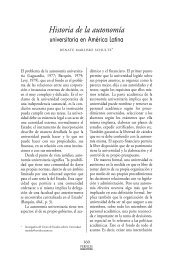intellectual property and the cultural aspects of collaboration
intellectual property and the cultural aspects of collaboration
intellectual property and the cultural aspects of collaboration
Create successful ePaper yourself
Turn your PDF publications into a flip-book with our unique Google optimized e-Paper software.
Table 2: U.S. patents granted by inventor residence:1985 1990 1994 2000U.S. Origin 39,556 47,390 56,066 85,070Canadian Origin 1,342 1,859 2,008 3,419Mexican Origin 32 32 44 76O<strong>the</strong>r Foreign Origin 30,731 41,083 43,558 68,930Total 71,661 90,364 101,676 157,495Source: National Science Board, 2000 <strong>and</strong> 2004Table 3: Patents granted in NAFTA countries to non-residents <strong>and</strong> <strong>of</strong> U.S. origin::GrantingCountryPatentsto Non-Residentsas % <strong>of</strong>total1985 1990 1994 2000Patentsto U.S.as % <strong>of</strong>totalPatentsto Non-Residentsas % <strong>of</strong>totalPatentsto U.S.as % <strong>of</strong>totalPatentsto Non-Residentsas % <strong>of</strong>totalPatentsto U.S.as % <strong>of</strong>totalPatentsto Non-Residentsas % <strong>of</strong>totalPatentsto U.S.as % <strong>of</strong>totalCanada 92.8 54.8 92.2 52.2 92.7 51.3 90.8 56.9Mexico 93.4 56.3 92.0 63.4 93.4 58.0 98.0 58.7U.S. 44.8 55.2 47.6 52.4 44.9 55.1 46.0 54.0Source: National Science Board, 2000 <strong>and</strong> 2004Aboites (1993) argues that one implication for <strong>the</strong> least developed <strong>of</strong> <strong>the</strong> threeNAFTA partners is that protection <strong>of</strong> <strong>intellectual</strong> <strong>property</strong> may lead <strong>the</strong> Mexicaneconomy to warrant that knowledge that has been accumulated for multinationalcorporations would be protected by <strong>the</strong> Mexican government. Ano<strong>the</strong>r implication isthat, as most research <strong>and</strong> development (R&D) in Mexico is conducted at publicuniversities <strong>and</strong> research institutes, <strong>the</strong>ir agendas <strong>and</strong> research priorities would be setup in accordance to commercial ra<strong>the</strong>r than academic interests.Commercialization <strong>and</strong> Community Service.Given <strong>the</strong> potential <strong>of</strong> <strong>intellectual</strong> <strong>property</strong> commercialization to imperil <strong>the</strong>liberal university’s future, Claire Polster (2000) points out <strong>the</strong> importance <strong>of</strong>exploring how it works <strong>and</strong> how it may be resisted. She argues that dynamics set intomotion by <strong>the</strong> commercialization <strong>of</strong> <strong>intellectual</strong> <strong>property</strong> are eroding <strong>the</strong> university’sability to draw on <strong>and</strong> to replenish <strong>the</strong> <strong>intellectual</strong> commons—a fundamentalprecondition to <strong>the</strong> survival <strong>of</strong> <strong>the</strong> university. Because commercialization <strong>of</strong><strong>intellectual</strong> <strong>property</strong> changes <strong>the</strong> reward structure for faculty within <strong>the</strong> university,9


